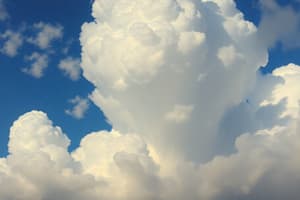Podcast
Questions and Answers
Explain how air temperature influences cloud formation.
Explain how air temperature influences cloud formation.
Cooler air holds less water vapor, making condensation more likely, which is essential for cloud formation.
What are some examples of lifting mechanisms that contribute to cloud formation?
What are some examples of lifting mechanisms that contribute to cloud formation?
Examples include frontal systems, orographic lifting, convergence, and convection.
Describe how clouds influence the Earth's climate.
Describe how clouds influence the Earth's climate.
Clouds reflect sunlight back into space, cooling the planet, and they absorb outgoing infrared radiation, warming the Earth.
What is the significance of clouds in terms of precipitation?
What is the significance of clouds in terms of precipitation?
Briefly explain the concept of cloud seeding.
Briefly explain the concept of cloud seeding.
What is the main process through which clouds are formed?
What is the main process through which clouds are formed?
What are condensation nuclei, and why are they important in cloud formation?
What are condensation nuclei, and why are they important in cloud formation?
Name the three classifications of clouds based on altitude and provide one example from each category.
Name the three classifications of clouds based on altitude and provide one example from each category.
Describe the characteristics of cumulonimbus clouds.
Describe the characteristics of cumulonimbus clouds.
What occurs during the process of evaporation?
What occurs during the process of evaporation?
Flashcards
Cloud Formation
Cloud Formation
The formation of clouds happens when water vapor in the air cools and condenses into tiny water droplets or ice crystals.
Cloud Classification
Cloud Classification
Cloud types are classified based on their shape and altitude. High clouds are above 6 km, middle clouds are between 2 and 6 km, and low clouds are below 2 km.
Cirrus Clouds
Cirrus Clouds
Cirrus clouds are thin and wispy, made of ice crystals. They often indicate fair weather.
Cumulus Clouds
Cumulus Clouds
Signup and view all the flashcards
Stratus Clouds
Stratus Clouds
Signup and view all the flashcards
Precipitation
Precipitation
Signup and view all the flashcards
Cloud seeding
Cloud seeding
Signup and view all the flashcards
Air Temperature's Impact on Clouds
Air Temperature's Impact on Clouds
Signup and view all the flashcards
Moisture Content and Cloud Formation
Moisture Content and Cloud Formation
Signup and view all the flashcards
Clouds' Climate Role
Clouds' Climate Role
Signup and view all the flashcards
Study Notes
Formation of Clouds
- Clouds form when atmospheric water vapor cools and condenses into tiny water droplets or ice crystals.
- Condensation requires tiny particles (condensation nuclei) like dust, pollen, or sea salt.
- Rising air cools adiabatically (without heat exchange) as it expands.
- Cooling air's capacity to hold water vapor decreases, causing condensation.
- Condensation altitude depends on air temperature and moisture.
- Different cloud types form at various altitudes due to atmospheric temperature changes.
Cloud Classification
- Clouds are categorized by shape and altitude:
- High clouds (above 6 km) are typically thin and wispy, composed of ice crystals. Examples: cirrus, cirrostratus, cirrocumulus.
- Middle clouds (2 to 6 km) are layered or patchy, white or gray. Examples: altostratus, altocumulus.
- Low clouds (below 2 km) are dense, layered or puffy. Examples: stratus, stratocumulus, nimbostratus.
- Clouds with vertical development span multiple altitudes. Examples: cumulus, cumulonimbus.
Cloud Types and Characteristics
- Cirrus: Thin, wispy, high-altitude ice crystal clouds, associated with fair weather.
- Cumulus: Puffy, white clouds with flat bases and rounded tops, often fair weather but can develop into thunderstorms.
- Stratus: Gray, layered clouds covering the entire sky, often producing light drizzle or light rain.
- Nimbostratus: Dark, thick, layered clouds producing continuous rain or snow.
- Cirrostratus: Thin, sheet-like clouds creating halo effects around the sun/moon.
- Altostratus: Gray or bluish-gray layered clouds potentially producing light precipitation.
- Altocumulus: White or gray puffy clouds in layers or patches, often in groups; not typically associated with heavy precipitation.
- Cumulonimbus: Large towering clouds with dark bases, producing heavy rain, hail, thunder, and lightning.
Cloud Processes
- Condensation: Water vapor changing from gas to liquid when air cools below its dew point.
- Evaporation: Liquid water turning into water vapor.
- Sublimation: Ice changing directly to water vapor, or vice versa.
- Precipitation: Water falling from clouds as rain, snow, sleet, or hail.
- Cloud seeding: Introducing artificial condensation nuclei to modify precipitation.
Factors Influencing Cloud Formation
- Temperature: Cooler air holds less water vapor, increasing condensation likelihood.
- Moisture content: Higher water vapor content promotes cloud formation. Rising air cools as it expands in altitude.
- Atmospheric stability: Stable conditions hinder cloud formation; unstable conditions encourage vertical development.
- Lifting mechanisms: Frontal systems, orographic lifting (mountains), convergence, and convection (thermal heating) force air upward, cooling and condensing, thus forming clouds.
Cloud Importance
- Clouds are vital to Earth's climate system.
- They reflect sunlight, cooling the planet.
- They absorb outgoing IR radiation from the Earth, warming it.
- Clouds are essential for precipitation, providing water to ecosystems.
- Clouds influence visibility and weather patterns by blocking sunlight.
Studying That Suits You
Use AI to generate personalized quizzes and flashcards to suit your learning preferences.
Description
Explore how clouds are formed from water vapor in the atmosphere and the role of condensation nuclei. Learn about the different types of clouds classified by shape and altitude, including high, middle, and low clouds. This quiz will deepen your understanding of cloud formation processes and classifications.





